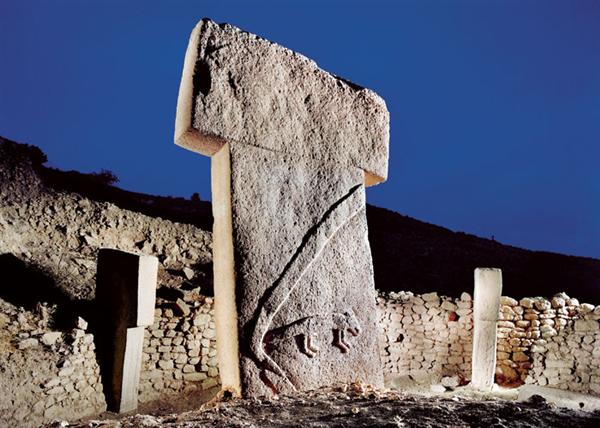
They call it potbelly hill, after the soft, round contour of this final lookout in southeastern Turkey. To the north are forested mountains. East of the hill lies the biblical plain of Harran, and to the south is the Syrian border, visible 20 miles away, pointing toward the ancient lands of Mesopotamia and the Fertile Crescent, the region that gave rise to human civilization. And under our feet, according to archeologist Klaus Schmidt, are the stones that mark the spot—the exact spot—where humans began that ascent.
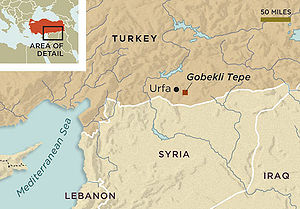 Standing on the hill at dawn, overseeing a team of 40 Kurdish diggers, the German-born archeologist waves a hand over his discovery here, a revolution in the story of human origins. Schmidt has uncovered a vast and beautiful temple complex, a structure so ancient that it may be the very first thing human beings ever built. The site isn’t just old, it redefines old: the temple was built 11,500 years ago—a staggering 7,000 years before the Great Pyramid, and more than 6,000 years before Stonehenge first took shape. The ruins are so early that they predate villages, pottery, domesticated animals, and even agriculture—the first embers of civilization. In fact, Schmidt thinks the temple itself, built after the end of the last Ice Age by hunter-gatherers, became that ember—the spark that launched mankind toward farming, urban life, and all that followed.
Standing on the hill at dawn, overseeing a team of 40 Kurdish diggers, the German-born archeologist waves a hand over his discovery here, a revolution in the story of human origins. Schmidt has uncovered a vast and beautiful temple complex, a structure so ancient that it may be the very first thing human beings ever built. The site isn’t just old, it redefines old: the temple was built 11,500 years ago—a staggering 7,000 years before the Great Pyramid, and more than 6,000 years before Stonehenge first took shape. The ruins are so early that they predate villages, pottery, domesticated animals, and even agriculture—the first embers of civilization. In fact, Schmidt thinks the temple itself, built after the end of the last Ice Age by hunter-gatherers, became that ember—the spark that launched mankind toward farming, urban life, and all that followed.Göbekli Tepe—the name in Turkish for "potbelly hill"—lays art and religion squarely at the start of that journey. After a dozen years of patient work, Schmidt has uncovered what he thinks is definitive proof that a huge ceremonial site flourished here, a "Rome of the Ice Age," as he puts it, where hunter-gatherers met to build a complex religious community. Across the hill, he has found carved and polished circles of stone, with terrazzo flooring and double benches. All the circles feature massive T-shaped pillars that evoke the monoliths of Easter Island.
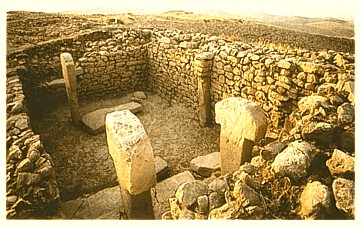
Though not as large as Stonehenge—the biggest circle is 30 yards across, the tallest pillars 17 feet high—the ruins are astonishing in number. Last year Schmidt found his third and fourth examples of the temples. Ground-penetrating radar indicates that another 15 to 20 such monumental ruins lie under the surface. Schmidt’s German-Turkish team has also uncovered some 50 of the huge pillars, including two found in his most recent dig season that are not just the biggest yet, but, according to carbon dating, are the oldest monumental artworks in the world.
The new discoveries are finally beginning to reshape the slow-moving consensus of archeology. Göbekli Tepe is "unbelievably big and amazing, at a ridiculously early date," according to Ian Hodder, director of Stanford’s archeology program. Enthusing over the "huge great stones and fantastic, highly refined art" at Göbekli, Hodder—who has spent decades on rival Neolithic sites—says: "Many people think that it changes everything…It overturns the whole apple cart. All our theories were wrong."
Schmidt’s thesis is simple and bold: it was the urge to worship that brought mankind together in the very first urban conglomerations. The need to build and maintain this temple, he says, drove the builders to seek stable food sources, like grains and animals that could be domesticated, and then to settle down to guard their new way of life. The temple begat the city.
Video from: YouTube.com
This theory reverses a standard chronology of human origins, in which primitive man went through a "Neolithic revolution" 10,000 to 12,000 years ago. In the old model, shepherds and farmers appeared first, and then created pottery, villages, cities, specialized labor, kings, writing, art, and—somewhere on the way to the airplane—organized religion. As far back as Jean-Jacques Rousseau, thinkers have argued that the social compact of cities came first, and only then the "high" religions with their great temples, a paradigm still taught in American high schools.
Religion now appears so early in civilized life—earlier than civilized life, if Schmidt is correct—that some think it may be less a product of culture than a cause of it, less a revelation than a genetic inheritance. The archeologist Jacques Cauvin once posited that "the beginning of the gods was the beginning of agriculture," and Göbekli may prove his case.
The builders of Göbekli Tepe could not write or leave other explanations of their work. Schmidt speculates that nomadic bands from hundreds of miles in every direction were already gathering here for rituals, feasting, and initiation rites before the first stones were cut. The religious purpose of the site is implicit in its size and location. "You don’t move 10-ton stones for no reason," Schmidt observes. "Temples like to be on high sites," he adds, waving an arm over the stony, round hilltop. "Sanctuaries like to be away from the mundane world."
Unlike most discoveries from the ancient world, Göbekli Tepe was found intact, the stones upright, the order and artistry of the work plain even to the un-trained eye. Most startling is the elaborate carving found on about half of the 50 pillars Schmidt has unearthed. There are a few abstract symbols, but the site is almost covered in graceful, naturalistic sculptures and bas-reliefs of the animals that were central to the imagination of hunter-gatherers. Wild boar and cattle are depicted, along with totems of power and intelligence, like lions, foxes, and leopards. Many of the biggest pillars are carved with arms, including shoulders, elbows, and jointed fingers. The T shapes appear to be towering humanoids but have no faces, hinting at the worship of ancestors or humanlike deities. "In the Bible it talks about how God created man in his image," says Johns Hopkins archeologist Glenn Schwartz. Göbekli Tepe "is the first time you can see humans with that idea, that they resemble gods."
The temples thus offer unexpected proof that mankind emerged from the 140,000-year reign of hunter-gatherers with a ready vocabulary of spiritual imagery, and capable of huge logistical, economic, and political efforts. A Catholic born in Franconia, Germany, Schmidt wanders the site in a white turban, pointing out the evidence of that transition. "The people here invented agriculture. They were the inventors of cultivated plants, of domestic architecture," he says.
Göbekli sits at the Fertile Crescent’s northernmost tip, a productive borderland on the shoulder of forests and within sight of plains. The hill was ideally situated for ancient hunters. Wild gazelles still migrate past twice a year as they did 11 millennia ago, and birds fly overhead in long skeins. Genetic mapping shows that the first domestication of wheat was in this immediate area—perhaps at a mountain visible in the distance—a few centuries after Göbekli’s founding. Animal husbandry also began near here—the first domesticated pigs came from the surrounding area in about 8000 B.C., and cattle were domesticated in Turkey before 6500 B.C. Pottery followed. Those discoveries then flowed out to places like Çatalhöyük, the oldest-known Neolithic village, which is 300 miles to the west.
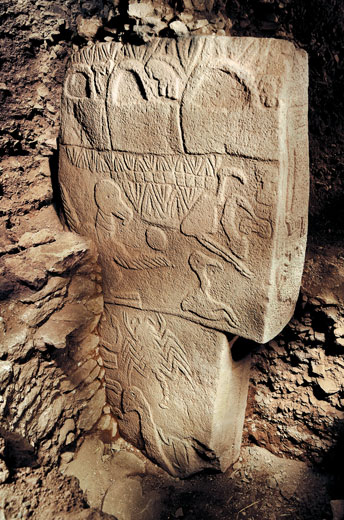 The artists of Göbekli Tepe depicted swarms of what Schmidt calls "scary, nasty" creatures: spiders, scorpions, snakes, triple-fanged monsters, and, most common of all, carrion birds. The single largest carving shows a vulture poised over a headless human. Schmidt theorizes that human corpses were ex-posed here on the hilltop for consumption by birds—what a Tibetan would call a sky burial. Sifting the tons of dirt removed from the site has produced very few human bones, however, perhaps because they were removed to distant homes for ancestor worship. Absence is the source of Schmidt’s great theoretical claim. "There are no traces of daily life," he explains. "No fire pits. No trash heaps. There is no water here." Everything from food to flint had to be imported, so the site "was not a village," Schmidt says. Since the temples predate any known settlement anywhere, Schmidt concludes that man’s first house was a house of worship: "First the temple, then the city," he insists.
The artists of Göbekli Tepe depicted swarms of what Schmidt calls "scary, nasty" creatures: spiders, scorpions, snakes, triple-fanged monsters, and, most common of all, carrion birds. The single largest carving shows a vulture poised over a headless human. Schmidt theorizes that human corpses were ex-posed here on the hilltop for consumption by birds—what a Tibetan would call a sky burial. Sifting the tons of dirt removed from the site has produced very few human bones, however, perhaps because they were removed to distant homes for ancestor worship. Absence is the source of Schmidt’s great theoretical claim. "There are no traces of daily life," he explains. "No fire pits. No trash heaps. There is no water here." Everything from food to flint had to be imported, so the site "was not a village," Schmidt says. Since the temples predate any known settlement anywhere, Schmidt concludes that man’s first house was a house of worship: "First the temple, then the city," he insists.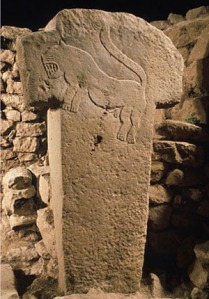
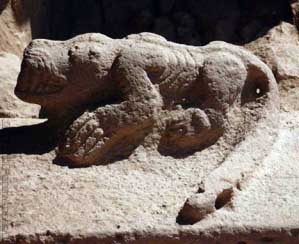
Some archeologists, like Hodder, the Neolithic specialist, wonder if Schmidt has simply missed evidence of a village or if his dating of the site is too precise. But the real reason the ruins at Göbekli remain almost unknown, not yet incorporated in textbooks, is that the evidence is too strong, not too weak. "The problem with this discovery," as Schwartz of Johns Hopkins puts it, "is that it is unique." No other monumental sites from the era have been found. Before Göbekli, humans drew stick figures on cave walls, shaped clay into tiny dolls, and perhaps piled up small stones for shelter or worship. Even after Göbekli, there is little evidence of sophisticated building. Dating of ancient sites is highly contested, but Çatalhöyük is probably about 1,500 years younger than Göbekli, and features no carvings or grand constructions. The walls of Jericho, thought until now to be the oldest monumental construction by man, were probably started more than a thousand years after Göbekli. Huge temples did emerge again—but the next unambiguous example dates from 5,000 years later, in southern Iraq.
The site is such an outlier that an American archeologist who stumbled on it in the 1960s simply walked away, unable to interpret what he saw. On a hunch, Schmidt followed the American’s notes to the hilltop 15 years ago, a day he still recalls with a huge grin. He saw carved flint everywhere, and recognized a Neolithic quarry on an adjacent hill, with unfinished slabs of limestone hinting at some monument buried nearby. "In one minute—in one second—it was clear," the bearded, sun-browned archeologist recalls. He too considered walking away, he says, knowing that if he stayed, he would have to spend the rest of his life digging on the hill.
Now 55 and a staff member at the German Archaeological Institute, Schmidt has joined a long line of his countrymen here, reaching back to Heinrich Schliemann, the discoverer of Troy. He has settled in, marrying a Turkish woman and making a home in a modest "dig house" in the narrow streets of old Urfa. Decades of work lie ahead.
Disputes are normal at the site—the workers, Schmidt laments, are divided into three separate clans who feud constantly. ("Three groups," the archeologist says, exasperated. "Not two. Three!") So far Schmidt has uncovered less than 5 percent of the site, and he plans to leave some temples untouched so that future researchers can examine them with more sophisticated tools.
Whatever mysterious rituals were conducted in the temples, they ended abruptly before 8000 B.C., when the entire site was buried, deliberately and all at once, Schmidt believes. The temples had been in decline for a thousand years—later circles are less than half the size of the early ones, indicating a lack of resources or motivation among the worshipers. This "clear digression" followed by a sudden burial marks "the end of a very strange culture," Schmidt says. But it was also the birth of a new, settled civilization, humanity having now exchanged the hilltops of hunters for the valleys of farmers and shepherds. New ways of life demand new religious practices, Schmidt suggests, and "when you have new gods, you have to get rid of the old ones."
Article from: Newsweek.com

Fascinating. Thank you or sharing your findings and knowledge.
ReplyDeletemore proof of Noah's flood. Everything was buried completely and suddenly.
ReplyDeleteNot sure how this is proof of "Noah's" flood, seeing as the story of Noah is almost an exact copy of multiple other stories that predate Christianity by quite a few years. And if you look into the evidence of this city some more, you'll find that the dig site looks like it was buried under sand intentionally.
DeleteThe place of genetic upgrade through shamanic meditation. Not a leaving behind of the old gods and creating the new, but of new harmonics, integration of new possibilities.
DeleteNope. Had to be God. 100 percent. Have some faith brother
DeleteActually kinda screws up the whole Bible version of the history of the human kind as, whereas according to the Bible the world is only around 10,000 years old, this archaeological site alone is 12,000 years old. Maybe someone should sit down and re-write the Bible, or at least write and addendum to it...
Delete^^ This guy is my hero
Deletenope, you are mistaken. The bible never claimed at any point that 10,000 years have past. That is just your interpretation. The point of the bible is not history (it just happens to have some history in it). The point of the Bible is to show people the character and actions of God with people in History. If you are asking the bible a question it doesn't address, go look some where else.
DeleteI think this is a brilliant and fascinating find.
Open mindedly speaking..would it be possible for flooding to carry in all that sand? and if maybe gods days are not the same as our days...this is edan from 12,000 years ago? more likely its from aliens tho...because how the heck did early man make such straight lines?the tools to make striaght lines, when u havent even discovered the wheel or language!? pretty cool.
Deletewho said they didn't know about the wheel, or know how to write or have language. How would God speak to his people if he didn't give them at least basic knowledge and the intelligence to use it. Even babys learn all of this with out much help sometimes. Natural progression.
DeleteAnonymous is right. Recently, someone put laptops on the streets in some extremely poor villages with little or no education available, and provided no instruction on how to use them. By the time the experimenter came back -- six months later, as I recall -- the children had figured out how to use the laptops and, when asked if they'd had any trouble with it, commented on some complicated genetics issue they'd been reading about online.
DeletePrimitive does NOT mean stupid.
Proof of Noahs flood??
ReplyDeleteIf that was the case, which means the settlement (For want of a better word) was occupied for thousands of years then suddenly buried. Don't you think there would be human remains? Pottery? Tools? ANY sign of life? I'm not saying you're wrong about God, that is your belief and you're entitled to it. But don't you think that taking discoveries like this and just saying "See, it said that in the bible" is a bit niaive?
The flood is purported to be around 2300BC meaning that this was occupied for over 9000 years!!!!
Sorry, but creationism says humans have only existed for around 6000 years, this kind of debunks that don't you think?
Nope, God did it. Clear as day. Don't need facts when you have faith!
Deletethe monoliths are giant dicks
ReplyDeleteOk. 2nd paragraph 5th line. "first thing humans built" Really? Does he mean that.
DeleteOk,9th paragraph, " ...could'nt write" ! Careful now, You must mean -'no evidence of writing'. eg, you may find no writing on many modern structures, is that proof of no writing? Consider that they may have had writing on papyrus os parchment.
Paragraph 10, 'T' shapes appear to be towering humanoids..... god created man in his own image ???? The 'T' shapes do not look like humans, evidence of skilled masonry is present, if they wanted them to look like humans..... surely they would.
P' 14, Catal huyuk does have temples and grand carvings, ( as illustrated in an open book beside me here , The Time Falling Bodies Take to Light. William Irwin Thompson, p139 ).
Be careful of what these people say. They are excited about their discovery and quite rightly, but in their excitement watch how they turn speculation in one sentence into fact the next.
Well said ! By the sound of it, the dig is still in its early stages, never mind our understanding of it.
DeleteI find it quite funny that they say this disproves our previous theories, and then the go ahead and use this find as the foundation of more speculation and theory !
Fascinating !! Thank you for revealing these findings. Time will tell us more.
ReplyDeleteThere are 3 earth AGES,we are in THE 2nd,...Rod
ReplyDeleteI hope we are coming to an end soon the second age stinks..
DeleteTantalizing! That place is old, but I have a feeling civilization is much, much older than the currently accepted range. Just consider racial differences, and how much time evolution takes to accomplish such differences. There must have been great populations of every race extant, implying civilization to some degree in order to have enough people to constitute a 'race' as opposed to an anomaly. Fascinating, and infuriating we don't have more...
ReplyDeleteThis comment has been removed by the author.
Deletethere doesn't need to be many people to constitute a race, a society just has to be isolated enough for long enough to cause genetic differences, races were formed in the hunter-gatherer days starting with human evolution and running up to the present (despite globalization). There is no correlation between civilization and racial differences.
DeleteIt is simply amazing. This discovery has shattered the myths about creationists who posits that man had first walked on earth about 6000 years ago.
ReplyDeletelol. What evidence has ever been shown to conclusively show these sites are as old as they say? Not saying they aren't, but every story of a find is based on a guess on top of another guess. This shatters nothing but a rational person's faith in archaeology. There is literally nothing that would indicate the age of this place. Carbon dating of items that no one alive today can say were not already thousands of years old when they were made? Dating of other items that no one alive today can say were not contaminated over thousands of years? This site could be 20,000 years old or 3,000 or any other number. If its not driven by science and instead some pseudo-science and guess work its pointless.
ReplyDeleteCarbon Dating is an amazing thing.
DeleteActually, in this case it would be radiocarbon dating... But either way, both are amazing tools.
DeleteActually, carbon dating is based on solid math and physics knowledge. One of the ways it was calibrated was by using ring patterns from still living Bristlecone pines that live in excess of 5000 years, and then taking the overlap of the living trees with trees that were preserved and in many cases even used in ancient constructions by nearby tribes. All trees living in the same area are subject to the same weather and hence they have similar growth patterns. In this manner, it is possible to calibrate and then further extrapolate in order to refine the accuracy of carbon 14 dating. That being said, chances are they have a pretty good idea of the dates but that is not to say that things that date back further are not still buried there.
Delete^^This^^
DeleteThe man is just sticking to the status quo... he does not to be ostracised by the estabishment. It wasn't built by stone age hunter gatherers. There was an advanced civilisation in existence prior to a cataclysm that was later called the flood. This disaster effectively sent those that remained back to the stone age apart from a few artisans who then began the process of rebuilding. My guess is that the Atlantic Ocean was held back from the Mediterranean Basin by a land bridge spanning Africa and Spain.... this broke open and flooded the civilisations inhabiting the Med Basin....
ReplyDeleteHey! It is just a theory and no less unbelievable than anything else out there....
It's ignorant to think that the dating of these sites is guesswork. You say that something could be thousands of years old prior to its manufacture?? I assume you are talking about the stone. Stone is not carbon dated. The dating would have been carried out on bone or other organics found on site or timbers found at same sediment layers as site. This is not religion it is a science. They don't fill in the blanks with make believe , they scrutinise it until they are sure.
ReplyDeleteGod hates fags. Smoking just one marijuana joint has been proven to increase your risk of being gay by 327%!!! So don't make God angry or else he'll bury you in sand...it's that simple.
DeleteHmmm... you may be overstating the certainties of science. Science, by its own admission, consists of theories, some of which have been proven to most peoples' satisfaction, and some of which are still just best guesses, subject to further study. This is the inherent strength in science: the willingness to question, revise, test, and update as new information is found. But it's still all theory and conjecture.
ReplyDeleteit's better than the blind faith of a book saying the world was made 6 thousand years old 1 day after the sun and then the rest of the universe by an invisible dude...
DeleteIn technical or scientific use, Theory, principle, and law represent established, evidence-based explanations accounting for currently known facts or phenomena or for historically verified experience: the theory of relativity, the germ theory of disease, the law of supply and demand, the principle of conservation of energy. Often the word law is used in reference to scientific facts that can be reduced to a mathematical formula: Newton's laws of motion. In these contexts the terms theory and law often appear in well-established, fixed phrases and are not interchangeable. In both technical and nontechnical contexts, theory can also be synonymous with hypothesis, a conjecture put forth as a possible explanation of phenomena or relations, serving as a basis for thoughtful discussion and subsequent collection of data or engagement in scientific experimentation in order to rule out alternative explanations and reach the truth. In these contexts of early speculation, the words theory and hypothesis are often substitutable for one another: Remember, this idea is only a theory/hypothesis; Pasteur's experiments helped prove the theory/hypothesis that germs cause disease. Obviously, certain theories that start out as hypothetical eventually receive enough supportive data and scientific findings to become established, verified explanations. Although they retain the term theory in their names, they have evolved from mere conjecture to scientifically accepted fact.
DeleteYou may also be missing the terminological difference between "hypothesis" and "theory".
DeleteA theory is a hypothesis that has survived testing; it *cannot* be "just best guesses".
Barny Bulgaria
ReplyDeleteThere's ruins in Bulgaria dating back 8000 years ! which makes sense as its next to Turkey,not sure if a ' temple' came first though,could have been the 'kings'/leaders palace at the time,and i believe 'civilization' to be older,just needs finding,as for sudden demise ? Earthquakes,shifting sands or even water/drought,flooding or sea change,that to we may later find out.As for the 'Bible' ?its a kind of diary written by man ,of the time dated,and probably uneducated ,and only about that region (Middle east)
There are ruins on Mars that indicate three pyramid structures and what looks like a face aligned very closely to our three Great Pyramids and Sphinx. Both sites align with the constellation Orion. However, the Mars site aligns with it approximately 17,000 years ago. For all we know, we we're an alien civilization on Mars who had the technology to come to Earth when the atmosphere became poisonous and the river beds dried. In addition to that, a whole piece of history could be stuck within tectonic plates that have collided or pushed over each other throughout time. We may never know what happened in that period of existence. Just a thought.
ReplyDeleteI referenced the "face" and "pyramids" on Mars. Although fascinating, it is doubtful to myself and competent scientists that they are "made" by beings. I don't think it matters how we got here, we are here now. If God indeed created everything, it only matters if He decides to destroy it. There is mass corruption and disbelief among humans. We are far more corrupt than any previous civilization could be! Don't you think we have pissed Him off enough to do that by now? If we are alien, who cares? Again, we are here now. Maybe the evidence is still buried, or perhaps lost forever in the belly of the planet. It doesn't matter. What does matter is the present. There are very creepy things going on now that must be fixed or we aren't going to have to worry about God or aliens. In fact, we won't even be able to!!! Wake up people, this is just another distraction. Something for dummies to argue about. Period!
ReplyDeleteWow! Just amazing. Nothing to do with God.
ReplyDeleteI like the ocean busting through where Spain was connected to Gibraltar theory, but I've always thought that was much later - Sunk Atlantis yada yada...but this place may have already been abandoned, then, later got covered with sand in the flood.
ReplyDeleteI could see they didn't have written language, but they must have had some counting/measuring system.
"the temple was built 11,500 years ago" Actually it was buried 11,500 years ago, it could be thousands of years older.
ReplyDelete*facepalms* This dig is %5 uncovered and the archaeologist makes the proclamation that it is the oldest religious site in the world and that religion moved man to greater things. Carrion bird on a headless corpse. I think we are jumping the gun here as far as saying this is any kind of proof. Hopefully just because this guy has control of the site, it won't exclude unbiased archaeologists to evaluate what it is.
ReplyDelete